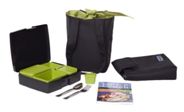Kids head back to school and moms gear up for an entire school year of
sack lunches!
Becky Low, with the Dairy Farmers of Utah, has ideas and inspiration to
help you pack healthy lunches your kids will eat!
At the beginning of school health conscious parents ask: “What should I
pack in my child’s school lunch?” According to research the question
perhaps should be “Should I pack it or should I purchase it?” The body of
research shows kids who eat school lunch have overall better diets than
those who pack a lunch from home (or worse yet, skip lunch, eat from the
vending machine or fast food). They drink more milk, eat more vegetables
and fruit, and have lower percentage of fat in their diets than home packed
lunches – and they do it at a lower cost. So what are the key principles used
by schools? In order to qualify for national school lunch program school
meals must meet the following criteria (use the same guidelines for your
child’s home packed meal, add variety and do it for $1.25-$2.00 per meal):
Include milk, fruit, vegetable, whole grain, lean protein
Meet 1/3 the daily requirements for Calcium, Iron, Vitamin A and Vitamin
C, and calories
Less than 30% of the calories from fat (averaged over one week) and less
than 10% saturated fat
Safe Temperatures (below 40 degrees or above 140 degrees F)
Less than 1,000 mg sodium (Utah)
When making sandwiches and bagging lunches consider 5 tips for packing
lunch which will help meet the above guidelines:
1. Create a menu: Prepare a menu or list of foods with your child that he or
she likes and you find acceptable. Keep the list handy and add to it as the
year progresses. More detail fosters variety. Selecting foods from each of
the groups below will help ensure key nutrients are consumed. This list
serves as a reminder and will help time crunched parents plan ahead. It is
similar to a cycle menu used by school lunch. Start with the list below, mix
and match foods from each group, add your own.
2. Make it easy and appealing: Slice and dice foods when possible. As
needed, place sliced fruit in pineapple juice or orange juice or treat with
Fruit Fresh to prevent browning. Include dips to encourage eating veggies.
Kids drink more milk if it’s chocolate. The small amount of added fat or
sugar is a big payoff when kids eat the nutrient rich foods (it isn’t healthy if
they don’t eat it).
3. Keep it safe: Use insulated lunch bags, boxes, thermos and ice packs to
help keep foods cold. Create your own edible ice pack by freezing meats,
some fruit, vegetables, and milk (only partially freeze milk to ensure it will
thaw by lunchtime, shake well).Prepare thermos by warming or chilling it
before adding food: ie add hot water to warm thermos before adding hot
foods; add ice water before adding cold foods.
4. Reduce morning rush: Pack ahead when possible. The night before or
over the weekend prepare individual bags or containers of cut veggies and
place in the refrigerator; place freezable foods in bags or containers in
freezer; pre-portion crackers, nuts or other foods to be used during the
week.
5. Keep it balanced: Use dietary guidelines for lower fat, sugar and salt for
the entire meal, not individual foods; average fat, sugar and salt over a
week (or at least a couple of days) rather than focusing on a specific day or
individual foods. Balance high fat meals with low fat, high sodium meals
with low sodium, high sugar meals with low sugar. Watch for “added”
sugar, salt and fats not naturally occurring. Consider nutrition trade-offs.
For additional help go to www.MyPlate.gov and ,a
href=”http://www.nal.usda.gov/fnic/foodcomp/search/”>www.nal.usda.go
v/fnic/foodcomp/search/ Use a recipe analysis program. Here is a
link to several analysis programs. Prices and features vary www.per-
serving.org/links.asp
Using the table in step 1, below are 7 sample menus.
Chow Mein
Chow Mein veggies (pack in thermos)
Chow Mein noodles in sandwich box
Mandarin oranges cup
Milk
Fortune Cookie
Homemade Lunchies (Lunchables copycat)
Ham slice quarters
Cheese slice quarters
Whole wheat crackers
Crosscut carrot slices
Ranch dressing dip
Chocolate milk slush
Strawberries
Taco Salad (child will need to assemble all or part)
Torn lettuce
Frozen cooked taco meat
Kidney beans
Tomato, diced
Shredded cheese
Tortilla chips
Salsa dressing
Fat-free chocolate milk
Pineapple chunks
(NOTE – for convenience – freeze crumbled together kidney beans, taco
meat and cheese)
Pizza Sticks
Pizza dipping sauce (spaghetti sauce pack in thermos)
Bread sticks
Cheese stick
Melon Medley w/ fruit juice slush
Milk
Peanut Butter Dip
Peanut butter to go
Celery sticks
Apple slices dipped in orange juice
7 Grain bagel
Shelf stable flavored milk
Chicken Fajita Wrap
Grilled chicken strips, frozen
Peppers and onions
Black beans and corn
Tortilla
Cheese slice
Salsa cup
Strawberry milk w/ milk cubes
Sliced kiwi
(NOTE: to make wrap for younger children – place tortilla on flat surface,
line with cheese slices, add veggies and beans, add frozen chicken strips,
season to taste; tightly roll and wrap.)
Pulled Pork Sandwich
Southern Style Pulled Pork (frozen)
Thin multi grain buns
Frozen peas
Frozen peach slices
Milk
Frozen yogurt
For unique and fun lunch boxes and bags see: http://studio5.ksl.com/index.php?
nid=56&sid=11979432
For delicious dairy recipes and nutrition information, go to
www.DairyCouncilUTNV.com,www.NationalDairyCouncil.or
g or on Facebook
www.facebook.com/DairyUT
NV















Add comment